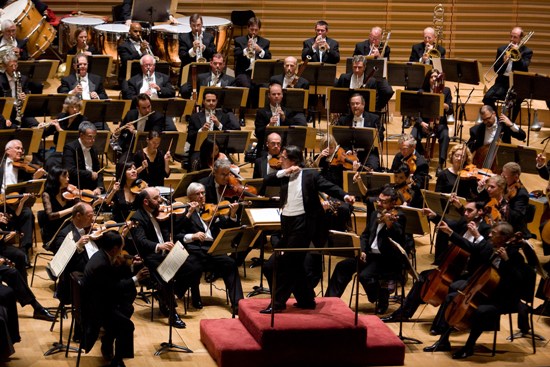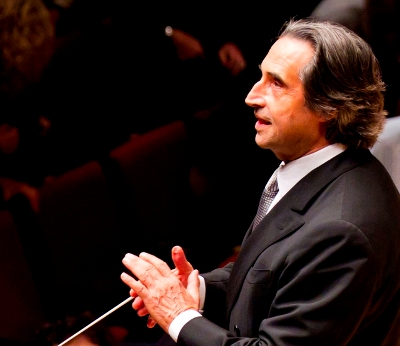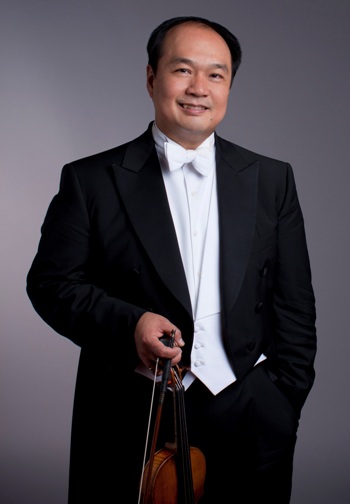With Muti again managing the house, CSO’s Bruckner Sixth becomes one splendid edifice
 Review: Chicago Symphony Orchestra conducted by Riccardo Muti through June 24. ****
Review: Chicago Symphony Orchestra conducted by Riccardo Muti through June 24. ****
By Nancy Malitz
One of the fascinations of this Chicago Symphony Orchestra season — which drew toward its close with an electric account of Beethoven’s Fifth Symphony last weekend and finishes Sunday with the final performance of Bruckner’s Sixth in its sumptuous glory — has been to hear various conductors come into the same acoustical space of Orchestra Hall, stand in the same spot where music director Riccardo Muti stands, and ply their art with the same band of a hundred-plus that Muti conducts.
 There is a qualitative difference in the sound signature that Muti molds within that hall, and in the artistic achievement of the collective musicians whom he has come to know. No hall is acoustically perfect, of course, and this one is easily over-excited at its bright top, capable of overpowering the specific voices in the CSO’s textural middle and lower-middle. It’s a pleasure to listen as the musicians come into exquisite focus when Muti’s here. He clears the din, allows us to share in the heady delight of its intensely pure pianissimos, its vivid inner life and its gift for voluptuous clarity. And when a thundering fortissimo does come, our ears are ready for it.
There is a qualitative difference in the sound signature that Muti molds within that hall, and in the artistic achievement of the collective musicians whom he has come to know. No hall is acoustically perfect, of course, and this one is easily over-excited at its bright top, capable of overpowering the specific voices in the CSO’s textural middle and lower-middle. It’s a pleasure to listen as the musicians come into exquisite focus when Muti’s here. He clears the din, allows us to share in the heady delight of its intensely pure pianissimos, its vivid inner life and its gift for voluptuous clarity. And when a thundering fortissimo does come, our ears are ready for it.
The Bruckner Sixth is not an orchestral standard. It was last done by the CSO in 1999, and its challenges are immediate in the first movement. The composer envisioned magical and prolonged undulations created by some higher-math syncopations involving overlayed triple and duple rhythms. Think of being on the river in a boat and watching the wind’s effect on the water’s surface, the leaves of a tree and a flock of birds simultaneously.
Bruckner’s intended rhythmic effect is like nature’s natural engine, alive and breathing. But one can imagine what it’s like to be a musician with one of those tricky parts, trying not to rock by boat by being off by an odd fraction of a fleeting pulse. Truth told, there were some moments of unsteadiness on Friday as the players performed this unwieldy work for the first time in the weekend. Orchestra and maestro were on mutual alert as they made their way through the first movement. But for this listener at least, the tension added to the excitement.
While the Sixth Symphony roughly follows the structural pattern laid down by Beethoven’s Ninth and seems familiar to the ear for its fundamental tonal grounding, it travels light years harmonically within that frame. The frequent repetition of easily remembered melodic patterns belies the dizzying distances this music takes us. Bruckner’s far-reaching modulations account for our sense that he has put us on the back of a comet tracing bizarre elliptical orbits that boomerang back via gravitation’s pull.
 This surprise-laden symphony reaches its greatest height in a slow movement of surpassing spiritual quiet, and Muti and the CSO reveled in it. Bruckner’s last two movements — a scherzo and grand meander of a finale — adopt some Wagnerian vocabulary in much the way Bernstein borrowed from Copland, through osmosis chiefly. Were those valkyries in that scherzo? Was Bruckner professing his loyalty to Wagner by alluding to the famous “ewig einig” motif from “Tristan und Isolde” at the grand climax of the finale, just before the movement rips to its sudden end? One almost feels cheated at that moment, as if Bruckner has made his obeisance, and then blushingly and hastily departs. He might well have lingered musically instead, giving us time to bask in the recognition that these two composers — one in silk pajamas and the friend of kings, the other a socially awkward provincial — each express a similarly ecstatic understanding of the human experience.
This surprise-laden symphony reaches its greatest height in a slow movement of surpassing spiritual quiet, and Muti and the CSO reveled in it. Bruckner’s last two movements — a scherzo and grand meander of a finale — adopt some Wagnerian vocabulary in much the way Bernstein borrowed from Copland, through osmosis chiefly. Were those valkyries in that scherzo? Was Bruckner professing his loyalty to Wagner by alluding to the famous “ewig einig” motif from “Tristan und Isolde” at the grand climax of the finale, just before the movement rips to its sudden end? One almost feels cheated at that moment, as if Bruckner has made his obeisance, and then blushingly and hastily departs. He might well have lingered musically instead, giving us time to bask in the recognition that these two composers — one in silk pajamas and the friend of kings, the other a socially awkward provincial — each express a similarly ecstatic understanding of the human experience.
Earlier this week, Muti told Chicago On the Aisle that he wishes to record complete cycles of the Beethoven and Bruckner symphonies with the CSO. If Muti’s last concerts of the season are samples of what might come, those recordings would be treasures to anticipate.
 While we’re on the broad subject of pairings: I found it curious to sit through a twinning of Nicolò Paganini’s First Violin Concerto with Bruckner’s Sixth on this final program of the season.
While we’re on the broad subject of pairings: I found it curious to sit through a twinning of Nicolò Paganini’s First Violin Concerto with Bruckner’s Sixth on this final program of the season.
The works are radically distant, the Bruckner the devoutly serious symphonic effort of a composer who never fully accommodated himself to the fashionable sophistication and thick skin that pursuit of fame in Vienna required, and the Paganini a savvy showpiece designed to enhance a virtuoso’s image as a demon fiddler and the toast of European capitals.
When Paganini introduced his Violin Concerto No. 1 at the age of 36, he was pushing the boundary of what was perceived as possible. Indeed a veritable encyclopedia of terms is used to describe the way he peppered melodies with his rapid-fire rebounding bow, managed dazzling plucked string effects and floated whistling high harmonics in harmony, all at blistering speed with seeming effortlessness. Paganini closely guarded his own techniques. Yet today they are viewed through the same historical prism as other once-unprecedented feats, like the triple Lutz, the Korbut flip and the four-minute mile.
There is no advanced violin student today who is not instructed to master the ricochet bowing, left-hand pizzicati and double-stop harmonics that were Paganini’s stock in trade. And if it is simply true that few students will achieve the clarity and ease with which Chicago Symphony concertmaster Robert Chen performed this novel showpiece on Friday, it’s also the plain case that the work itself is a bauble to show off with. Chen was clearly having some fun with it, and he turned right around after intermission to play the Bruckner as well. It that’s all in a night’s work, then he richly deserves the summer that’s upon us.
Related Links:
- Muti discusses Bruckner: Read it at Chicago On the Aisle
- 2012-13 Chicago Symphony season overview: Read it at Chicago On the Aisle
Photo captions and credits: Home page and top: Riccardo Muti conducts the Chicago Symphony at Orchestra Hall. (Todd Rosenberg) Descending: Chicago Symphony Orchestra Riccardo Muti addresses the audience. (Todd Rosenberg) Silhouette of Richard Wagner offering Anton Bruckner a pinch of snuff. (Otto Böhler) CSO concertmaster Robert Chen. (Todd Rosenberg)
Tags: Anton Bruckner, Chicago Symphony Orchestra, Nicolò Paganini, Riccardo Muti, Robert Chen

